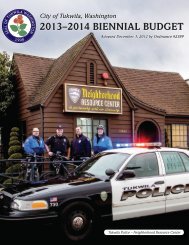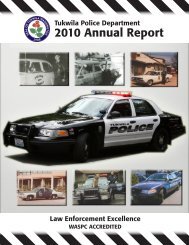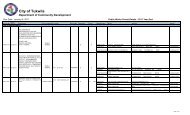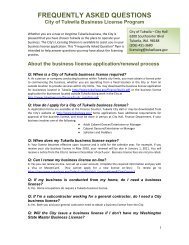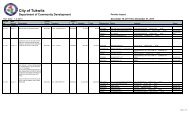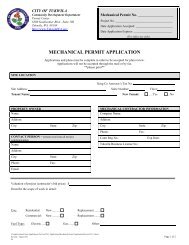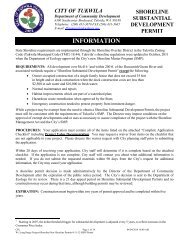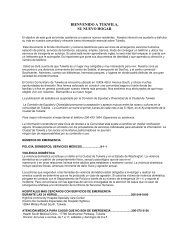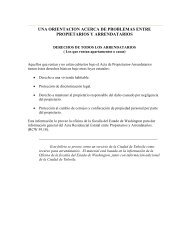2012 Comprehensive Annual Financial Report - the City of Tukwila
2012 Comprehensive Annual Financial Report - the City of Tukwila
2012 Comprehensive Annual Financial Report - the City of Tukwila
- No tags were found...
You also want an ePaper? Increase the reach of your titles
YUMPU automatically turns print PDFs into web optimized ePapers that Google loves.
CITY OF TUKWILA: <strong>2012</strong> CAFRNOTES TO THE FINANCIAL STATEMENTSNOTE 9 – PENSION PLANSWashington State Department <strong>of</strong> Retirement SystemsSubstantially all <strong>of</strong> <strong>the</strong> <strong>City</strong>’s full-time and qualifying part-time employees participate in one <strong>of</strong> <strong>the</strong>following statewide retirement systems administered by <strong>the</strong> Washington State Department <strong>of</strong> RetirementSystems, under cost-sharing multiple-employer public employee defined benefit retirement plans. TheDepartment <strong>of</strong> Retirement Systems (DRS), a department within <strong>the</strong> primary government <strong>of</strong> <strong>the</strong> State <strong>of</strong>Washington, issues a publicly available comprehensive annual financial report (CAFR) that includesfinancial statements and required supplementary information for each plan. The DRS CAFR may beobtained by writing to: Department <strong>of</strong> Retirement Systems, Communications Unit, PO Box 48380,Olympia, WA 98504-8380; or it may be downloaded from <strong>the</strong> DRS website atwww.drs.wa.gov/administration/annual-report/cafr/. The following disclosures are made pursuant toGASB Statements No. 27, Accounting for Pensions by State and Local Government Employers and No.50, Pension Disclosures, an Amendment <strong>of</strong> GASB Statements No. 25 and No. 27.Public Employees Retirement System (PERS) Plans 1, 2, and 3Plan DescriptionThe Legislature established PERS in 1947. Membership in <strong>the</strong> system includes: elected <strong>of</strong>ficials; stateemployees; employees <strong>of</strong> <strong>the</strong> Supreme, Appeals, and Superior courts ( o<strong>the</strong>r than judges currently in <strong>the</strong>Judicial Retirement System); employees <strong>of</strong> legislative committees; community and technical colleges,college and university employees not participating in higher education retirement programs; employees <strong>of</strong>district and municipal courts; and employees <strong>of</strong> local governments. Approximately 50 percent <strong>of</strong> PERSsalaries are accounted for by state employment. PERS retirement benefit provisions are established inChapters 41.34 and 41.40 RCW and may be amended only by <strong>the</strong> State Legislature.PERS is a cost-sharing multiple-employer retirement system comprised <strong>of</strong> three separate plans formembership purposes: Plans 1 and 2 are defined benefit plans and Plan 3 is a defined benefit plan with adefined contribution component.PERS members who joined <strong>the</strong> system by September 30, 1977 are Plan 1 members. Those who joinedon or after October 1, 1977 and by ei<strong>the</strong>r, February 28, 2002 for state and higher education employees,or August 31, 2002 for local government employees, are Plan 2 members unless <strong>the</strong>y exercised anoption to transfer <strong>the</strong>ir membership to Plan 3. PERS members joining <strong>the</strong> system on or after March 1,2002 for state and higher education employees, or September 1, 2002 for local government employeeshave <strong>the</strong> irrevocable option <strong>of</strong> choosing membership in ei<strong>the</strong>r PERS Plan 2 or PERS Plan 3. The optionmust be exercised within 90 days <strong>of</strong> employment. Employees who fail to choose within 90 days default toPERS Plan 3. Notwithstanding, PERS Plan 2 and Plan 3 members may opt out <strong>of</strong> plan membership ifterminally ill, with less than five years to live.PERS is comprise <strong>of</strong> and reported as three separate plans for accounting purposes: Plan 1, Plan 2/3, andPlan 3. Plan 1 accounts for <strong>the</strong> defined benefits <strong>of</strong> Plan 1 members. Plan 2/3 accounts for <strong>the</strong> definedbenefits <strong>of</strong> Plan 2 members and <strong>the</strong> defined benefit portion <strong>of</strong> benefits for Plan 3 members. Plan 3accounts for <strong>the</strong> defined contribution portion <strong>of</strong> benefits for Plan 3 members. Although members can onlybe a member <strong>of</strong> ei<strong>the</strong>r Plan 2 or Plan 3, <strong>the</strong> defined benefit portions <strong>of</strong> Plan2 and Plan 3 are accountedfor in <strong>the</strong> same pension trust fund. All assets <strong>of</strong> this Plan 2/3 defined benefit plan may legally be used topay <strong>the</strong> defined benefits <strong>of</strong> any <strong>of</strong> <strong>the</strong> Plan 2 or Plan 3 members or beneficiaries, as defined by <strong>the</strong> terms<strong>of</strong> <strong>the</strong> plan. Therefore, Plan 2/3 is considered to be a single plan for accounting purposes.PERS Plan 1 and Plan 2 retirement benefits are financed from a combination <strong>of</strong> investment earnings andemployer and employee contributions. Employee contributions to <strong>the</strong> PERS Plan 1 and Plan 2 definedbenefit plans accrue interest at a rate specified by <strong>the</strong> Director <strong>of</strong> DRS. During DRS’ Fiscal Year <strong>2012</strong>,<strong>the</strong> rate was five and on-half percent compounded quarterly. Members in PERS Plan 1 and Plan 2 can79



